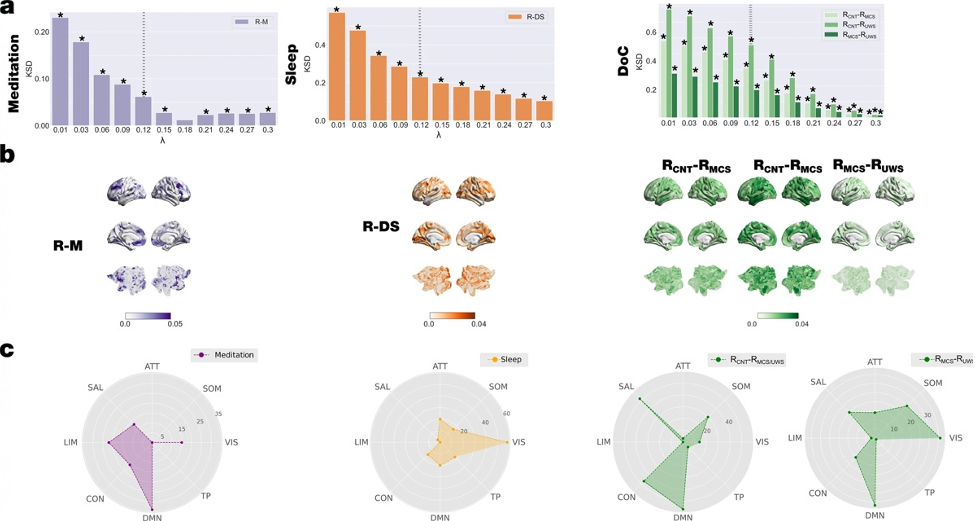- Research News
Turbulent dynamics in brain activity
03 November 2022
By analysing images obtained by functional magnetic resonance imaging (fMRI) and by computational modelling, HBP researchers from Universitat Pompeu Fabra (Spain) and other institutions have found that measuring the turbulence in brain dynamics enables them to distinguish between different brain states far more precisely than other pre-existing techniques.

A recent study by researchers of the Human Brain Project (HBP) provides a new approach to describing and distinguishing conscious and non-conscious brain states. The team investigated human neuroimaging data from different brain states (resting, meditation, deep sleep and disorders of consciousness after coma) and used computational modelling to study the information encoding capabilities in each of these brain states. The results demonstrate that measuring turbulence - or the dynamics of energy and information transfer - can be an excellent tool to differentiate between brain states.
“Describing and differentiating brain states is still a very difficult task to accomplish, and there is still no globally accepted frame of reference regarding which is the best variable to describe them. In this study, we report that the characterisation of brain activity with the use of measurements of turbulence allows distinguishing states with maximum precision, as if they were fingerprints of brain states,” says HBP researcher Gustavo Deco, of the Computational Neuroscience Group of the Center for Brain and Cognition (CBC) at the Universitat Pompeu Fabra (UPF), researcher at the Catalan Institution for Research and Advanced Studies (ICREA)and co-author of the study published in the journal Communications Biology. The team of scientists expects that these measurements of turbulence can be used as biomarkers.
The same group had already shown in a previous work that when the brain changes state, the different phases of brain activity appear and disappear synchronously. In this work they demonstrate that brain dynamics show spatiotemporal chaos, that is, at certain moments and in certain regions turbulence is generated and it is a very efficient way of transmitting information. “Turbulence is precisely that, chaos in space and time. And it is at that moment that the greatest transmission of energy occurs. The same happens with turbulence in water, for example, the greatest transmission of energy occurs when vortices are formed,” Deco continues.
The importance of turbulence is seen when we want to properly mix a soup, for example. The best way to mix all the ingredients is to perform a chaotic, random movement. If, however, we perform a laminar movement (the spoon always moving in one direction and with the same intensity) mixing will either not take place or will take a long time.
The researchers focused on comparing three conditions: a state of rest compared to one of meditation; comparing participants who were sleeping to others who were awake; and a medical case, with the participation of the Paris Brain Institute, and the Coma Science Group in Liège, Belgium, of patients with post-coma disorders of consciousness, such as a minimal consciousness state and unresponsive wakefulness syndrome (MCS and UWS), who were compared to healthy people or people who had recovered from coma.
They found differences in the information transfer patterns in the three groups. They also found these differences when they performed the measurements using computational models of overall brain activity, which allowed them to refine the measurements more precisely.
Is this the only way to study brain states?
“There are many methods to measure interactions in the brain,” Deco continues. “Some look at how the brain is segregated; others calculate the overall correlation of all interactions and select the mean value. They all distinguish between a conscious and an unconscious state, but none does so by directly considering the transmission of information the way we do, which allows us to obtain a fingerprint of turbulence and allows us to model it as we wish.”
Turbulence is present in all brain states. Anira Escrichs and Yonatan Sanz Perl, lead authors of the study and researchers with the same computational neuroscience group, add: “What has allowed us to characterise the different brain states is the way information is transferred across spatiotemporal scales. For example, in patients with disorders of consciousness, more information is transmitted on short spatial scales and less on large scales, while in sleeping participants, there is less information transmission on all scales.”
The study was supported by the Human Brain Project (HBP), the Spanish Ministry of Science and Innovation, and the Catalan Institute of Research and Advanced Studies (ICREA), among others. Researchers from the Department of Physics of the University of Buenos Aires, Argentina; the August Pi i Sunyer Institute of Biomedical Research (IDIBAPS); the Institute of Neurosciences of the University of Barcelona and the Brain Cognition and Plasticity Unit of the Bellvitge Biomedical Research Institute (IDIBELL) among others also participated.
Reference: Escrichs, A., Perl, Y.S., Uribe, C. et al. Unifying turbulent dynamics framework distinguishes different brain states. Commun Biol 5, 638 (2022). https://doi.org/10.1038/s42003-022-03576-6
Original press release in Spanish.



